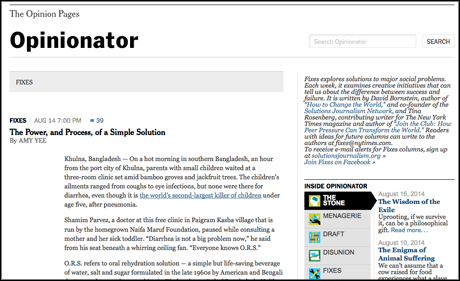
While the belief that 'if it bleeds it leads' – that bad news sells – is still very much out there, the idea of 'solutions' or 'constructive' journalism is built on the basis that people want more from the news they consume.
Constructive reporting aims to produce stories that give the audience a more comprehensive look around the issue at hand, focusing on solutions for problems rather than just the problems themselves.
Cathrine Gyldensted, a journalist who teaches at Denmark's School for Media and Journalism, has been planning to set up a national centre for constructive journalism in the belief that journalism urgently needs innovation, but on content rather than platforms.
According to Gyldensted, more and more people who use news media say they do not want such a negative 24/7 news cycle.
"What I would call constructive journalism engages readers and listeners and viewers more," she told Journalism.co.uk in a podcast last week. "We know that a sense of sadness... leaves people depressed and inactive. We know that feelings like awe and meaning in news stories create a sense of hope and a willingness to act."
Mallary Tenore, managing director of non-profit organisation Images and Voices of Hope, said whenever tragedy strikes, journalists report on "what happened" stories – telling audiences what happened, how many people died, what the devastation looked like.
"And these stories are important because they inform the public", she said, "but when these are the only stories that people hear, the world can start to feel like a cold and callous place."
Gyldensted said journalists should know more about how people share stories and how they want to act on them, to engage the audience in a more knowledgeable way.
In the op-ed section of the New York Times, a column called Fixes was set up to examine solutions to social problems. David Bornstein, a co-author of Fixes and co-founder of the Solutions Journalism Network, told Journalism.co.uk the media should also pay attention to the responses people have to the problems they face.
 Screengrab of the Fixes column, New York Times
Screengrab of the Fixes column, New York TimesHe said journalism spends most of its time diagnosing and surfacing problems, and while this watchdog function is crucial, reporters should also look at solutions around these issues and what can be learned from them.
But Bornstein said he does not believe the role of journalism is to make people feel a certain way.
"When we talk about solutions journalism or constructive journalism, it should not focus on 'positive news' or 'good news'," he said, "we really are very allergic to positive news or good news."
Instead, presenting the whole story means presenting the whole spectrum of responses around a particular problem, he said.
To write a solutions journalism story, Bornstein said reporters should know what the problem is and who the worst actors are, understand where the solution may lie, what is or is not working, and what can be learned from it all.
Bornstein called these stories "howdunnits", and said they read like Agatha Christie detective novels.
"It tends to be a very interesting story that can really grab the reader's curiosity," he said, "and if it works it might also turn out to grab their heart and really inspire them too. But that's not our primary goal.
"Our sense from Fixes is that solutions journalism is actually something that people want, but it's not because they want light, fluffy stuff or good news. They actually want information that helps them to understand the world and how to do better against these problems."
He said stories published in Fixes often make the top of the most emailed list on the New York Times website.
In a study by the Solutions Journalism Network and the Engaging News Project, over 700 people were asked questions about their responses to stories written in two different ways – one presenting just the problem, and one also featuring solutions.
It found that readers of stories that also explored ways of solving the problem raised were more likely to share them with their friends.
"Overwhelmingly for every single response there was a statistically significant difference between the way people engaged around the stories when they contained some mention of a response towards this problem," said Bornstein.
"We plan to do a lot more research in this area because we do think that there's a lot of potential for people to engage much more deeply with the news when it's not just 'oh here's a problem and then go home' – it's like here's a problem, here's five things that people are trying to do about it, four of them don't work, but one of them seems to be getting traction and this is why.
"That kind of journalism", he said, "that's really rigorous, grounded in evidence, independent not advocacy, is stuff that really gets people thinking."
*Listen to the full podcast and interviews with Gyldensted, Tenore and Bornstein here*.
Free daily newsletter
If you like our news and feature articles, you can sign up to receive our free daily (Mon-Fri) email newsletter (mobile friendly).
Related articles
- Audiences, AI and audio apps: five talking points from Perugia
- From Reuters to The New York Times, Big Oil pays 'most trusted media brands' to push greenwashing
- Four digital media trends to watch: generative AI, Gen Z, business models and news formats
- #MeToo inside the newsroom, with Jane Bradley and Lucy Siegle
- The NYT bets on edgy comedians and vloggers to make its opinion videos go viral









